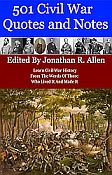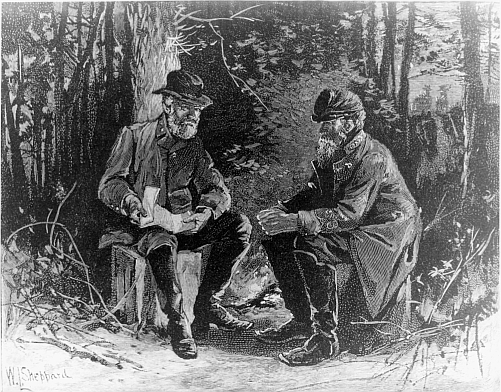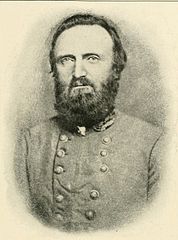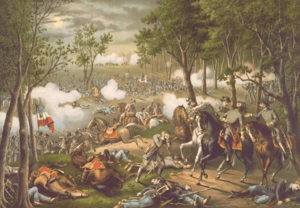Lee And Jackson Make Battle Plans
May 2, 1863
The night of May 1, Generals Robert E. Lee and Thomas Jonathan “Stonewall” Jackson are sitting on Union hardtack boxes by campfire. Lee and Jackson are working on their battle plans.
Outnumbered more than two to one, Lee still wants to take the offensive against Hooker. Lee knows the Federals hold a good defensive position on the high ground around Chancellorsville and the situation is too risky for a direct attack. Moreover, the Rappahannock River protects the Federal left, so turning it is impossible. Lee needs a way to go on the offensive. General Jeb Stuart soon provides the way.
Hooker’s Right Flank Is “in the air”
Stuart’s cavalry scouts have found that Hooker’s right flank has no natural or artificial obstacle to protect it, Hooker’s right flank is “in the air” and vulnerable. To move without detection around to the Federal right flank, Lee and Jackson need a route through the Wilderness. One of Stonewall Jackson’s staff officers finds a man who lives in the area and this local knows of a road used to haul charcoal to an iron-smelting furnace. Jackson can move his troops to the Federal right flank by using the charcoal-hauling road and a few other roads.
Lee’s Gamble
At Chancellorsville, Robert E. Lee gambles with his battle plans. Lee stays with only 15,000 men to face Hooker’s main force, while Jackson takes his corps of about 30,000 men through a way of roads and paths to the Federal right. Stuart’s cavalry will screen Jackson’s movement from the Federals and Lee will divert Hooker’s attention as Jackson’s men make their way. Meanwhile, General Jubal Early has his men at Fredericksburg.
Splitting the Army of Northern Virginia into three separate groups is a big risk. If Hooker chooses to take the offensive, then his superior number of troops can destroy any of Lee’s separated groups. Lee counts on “Fighting Joe” Hooker to do nothing while Stonewall Jackson makes his march to the Federal right flank.
Early the morning of May 2, Stonewall Jackson begins his march. As Lee remains behind with his relatively meager amount of troops, Jackson takes his 30,000 men on a twelve-mile march around Hooker’s army. Jackson has Stuart’s cavalry to screen his march, but Union infantry still detects the Rebel movements and troops under General Dan Sickles attack the tail of Jackson’s column.General “Fighting Joe” Hooker knows of Stonewall Jackson’s flanking movement, but Hooker thinks the Rebels are retreating instead of making offensive movements. Hooker does nothing to prepare for an attack on his right flank. By late in the afternoon of May 2, Stonewall has 30,000 men behind the unaware Federal troops.
A Rare Moonlight Fight
Stonewall Jackson tells Major Eugene Blackford: “You can go forward then,” and with their bone-chilling Rebel Yell battle cry the Confederates advance out of the cover of the Wilderness. The 11th Corps, under command of General Oliver O. Howard, have the Federal right. Mostly made up of German-Americans, the 11th Corps is about 12,000 strong. The 11th Corps, known as the “Dutch Corps” (a mangling of the word “Deutsche” for “German”), has a poor reputation based on previous battle action. Today would not improve the “Dutch Corps” reputation.
The Confederate attack took place near suppertime and most of Howard’s troops are preparing food or relaxing. The oncoming wall of attacking rebels surprises the Federals. By nightfall, Jackson’s men have backed the Federals up two miles. It was a moonlit night, and even after dark some fighting continues in the woods and thickets of the Wilderness. Night fighting was very rare in the Civil War, but this is an example of it. Finally, darkness ends the Confederate attack.
Tar Heels Fire Into The Darkness
General Thomas Jonathan “Stonewall” Jackson and several other officers are looking for a way to renew the attack. They are out ahead of their lines in the darkness and confusion of the Wilderness, scouting for the best way to begin a new attack. As they are returning to their lines at a trot, they come upon a regiment from North Carolina. In the dark, the Tar Heels hear the horses approaching and mistake their riders as Federals, the North Carolinians begin firing and Stonewall Jackson is struck.
A bullet hits Jackson in his right hand, a second in his left wrist, and a third strikes him in his left arm between the shoulder and elbow. Stonewall’s frightened horse bolts and runs toward the Federal lines, bashing Jackson’s face into a low tree branch before Jackson regains control of the horse. The third bullet is the most damaging to Jackson, it shatters bone and cuts an artery.Stonewall Jackson is severely injured. He is in great pain and moved to the rear on a stretcher, but not before urging his men to continue the fight and finish the victory. General Jeb Stuart assumes command of General Jackson’s 11th Corps.
Night has now fallen and the fighting ends for this day. The morning of May 3 would renew the Battle of Chancellorsville.
NEXT: Chancellorsville May 3 – 6, 1863
PREVIOUS: Chancellorsville May 1, 1863
 My book 501 Civil War Quotes and Notes features quotes made before, during, and after the Civil War. Each quote has an informative note to explain the circumstances and background of the quote. Learn Civil War history from the spoken words and writings of the military commanders, political leaders, the Billy Yanks and Johnny Rebs who fought in the battles, the abolitionists who strove for the freedom of the slaves, the descriptions of battles, and the citizens who suffered at home. Their voices tell us the who, what, where, when, and why of the Civil War. Available as a Kindle device e-book or as a paperback. Get 501 Civil War Quotes and Notes now!
My book 501 Civil War Quotes and Notes features quotes made before, during, and after the Civil War. Each quote has an informative note to explain the circumstances and background of the quote. Learn Civil War history from the spoken words and writings of the military commanders, political leaders, the Billy Yanks and Johnny Rebs who fought in the battles, the abolitionists who strove for the freedom of the slaves, the descriptions of battles, and the citizens who suffered at home. Their voices tell us the who, what, where, when, and why of the Civil War. Available as a Kindle device e-book or as a paperback. Get 501 Civil War Quotes and Notes now!



